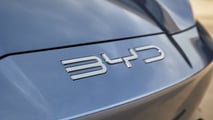
Everybody is talking about how Chinese-made electric vehicles are poised to take over the world. Their global sales numbers are increasing and more and more models are making their way into Europe and other global markets. But how does a Chinese EV that prides itself on being a worthy adversary to the popular Tesla Model 3 perform in the real world?
Thanks to the fine folks at the Nevo EV Review Ireland YouTube channel, we can get a better idea of what to expect from the BYD Seal. The car in the video embedded below was the dual-motor version electric sedan that boasts a WLTP-rated range of 323 miles when the 82.5-kilowatt-hour battery is fully charged.
Get Fully Charged
Chinese or American, Chinese-built EVs?
BYD is known as China's largest car maker, churning out hundreds of thousands of so-called new energy vehicles (NEVs) every quarter. It's also trying to establish a presence in Europe, where legacy automakers seem scared of the prospect of cheap EVs flooding the continent's streets. But what some of you might not know is that the European-spec Tesla Model 3 is also made in China, and nobody seems to care too much about that.
The BYD Seal AWD also has a combined 530 horsepower and can reach 62 miles per hour from a standstill in 3.8 seconds, all while carrying a price tag of around €50,000 ($54,400).
The video’s purpose is pretty straightforward: to find out if a coast-to-coast trip in Ireland is viable without stopping for a top-up along the way. That’s a roughly 199-mile journey that takes about 5 hours and includes highways, country roads and stop-and-go city traffic. The outside temperature was somewhere between 64 and 73 degrees Fahrenheit.
To cut to the chase, the BYD Seal had no issue and rose to the challenge. With 99% state of charge and 322 miles (519 km) indicated on the digital instrument cluster at the beginning of the trip, the Seal finished with 28% left and an indicated remaining range of 90 miles.
The average energy consumption for the entire journey was not shown in the video, but for the last 31 miles (50 km), which included a lot of city driving, the car recorded 17 kWh/100 km or 3.6 miles/kWh, which is pretty good. Another reading that popped up during the video showed the car had averaged 3 miles/kWh in the last 3,658 miles.
Gallery: 2024 BYD Seal Review







Comparatively, the official WLTP energy consumption rating for the BYD Seal AWD is 3.4 miles/kWh. Meanwhile, the Tesla Model 3 Long Range dual-motor has a WLTP-rated consumption of 4.4 miles/kWh–the higher, the better–and a WLTP-rated range of 390 miles, 67 more than the Seal, all while carrying a similar price tag. So on paper at least, Tesla’s sedan offers more bang for the buck, even if the WLTP rating is known to be more lenient compared to the EPA rating.
Furthermore, the actual real-world range of the Seal was roughly 34 miles shorter than what was shown on the instrument cluster at the beginning of the journey. But what do you think? Let us know in the comments below.







